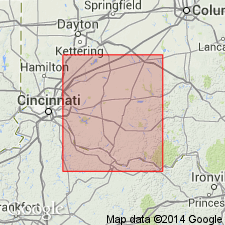
- Usage in publication:
-
- Mount Auburn concretionary shale member
- Modifications:
-
- Named
- Dominant lithology:
-
- Shale
- Limestone
- AAPG geologic province:
-
- Cincinnati arch
Summary:
Mount Auburn concretionary shale member named as upper member of McMillan formation in southern OH. Also referred to as PLATYSTROPHIA LYNX beds. Consists of shale, chiefly blue but in places yellowish, with some irregularly bedded limestone. Thickness 20 ft. Overlain by Warren beds [Arnheim formation] and underlain by Corryville or CHILOPORELLA NICHOLSONI beds. Age is Late Ordovician.
Source: GNU records (USGS DDS-6; Reston GNULEX).

- Usage in publication:
-
- Mount Auburn Member
- Modifications:
-
- Revised
- Overview
- AAPG geologic province:
-
- Cincinnati arch
Summary:
Grant Lake Limestone and Grant Lake Formation (of the informal Cincinnati group) are adopted by the Ohio Geological Survey for southwestern OH. The shale content of the Grant Lake Limestone progressively increases between Maysville, KY, and Cincinnati, OH. The term Grant Lake Formation is used where the unit becomes predominantly shale. The Grant Lake Formation is divided into (ascending) Bellevue, Corryville, and Mount Auburn Members. Name is applied in Butler, Hamilton, and Warren Cos. and in portions of Brown, Clermont, and Clinton Cos. The Grant Lake Limestone is divided into the Bellevue, Corryville, and Straight Creek Members. Name is applied in Adams and Highland Cos. and in portions of Brown, Clermont and Clinton Cos. The Mount Auburn Member consists mainly of interbedded, irregular-bedded, fissile-parted, fossiliferous shale and wavy- to nodular-bedded limestone. Mean shale percentage ranges from 50 to 79 percent. Lateral contact with the Straight Creek Member (new name) is gradational. The transitional zone winds from southeastern Clinton Co. to southeastern Clermont Co. The laterally equivalent members are differentiated from each other by mean shale percentage and limestone bedding styles. The Mount Auburn ranges in thickness from <6 m to >8 m.
Source: GNU records (USGS DDS-6; Reston GNULEX).

- Usage in publication:
-
- Mount Auburn Member*
- Modifications:
-
- Overview
- Age modified
- AAPG geologic province:
-
- Cincinnati arch
Summary:
Mount Auburn Member of Grant Lake Formation in OH is used in this report. Age is refined to Cincinnatian (Maysvillian).
Source: GNU records (USGS DDS-6; Reston GNULEX).
For more information, please contact Nancy Stamm, Geologic Names Committee Secretary.
Asterisk (*) indicates published by U.S. Geological Survey authors.
"No current usage" (†) implies that a name has been abandoned or has fallen into disuse. Former usage and, if known, replacement name given in parentheses ( ).
Slash (/) indicates name conflicts with nomenclatural guidelines (CSN, 1933; ACSN, 1961, 1970; NACSN, 1983, 2005, 2021). May be explained within brackets ([ ]).

